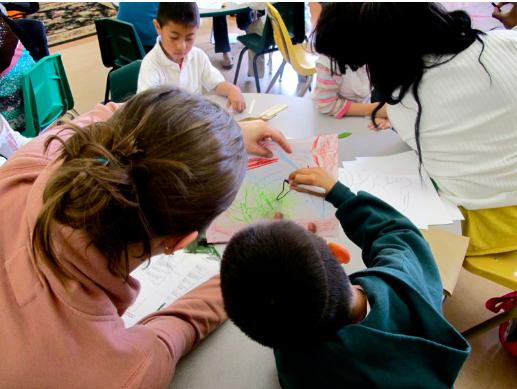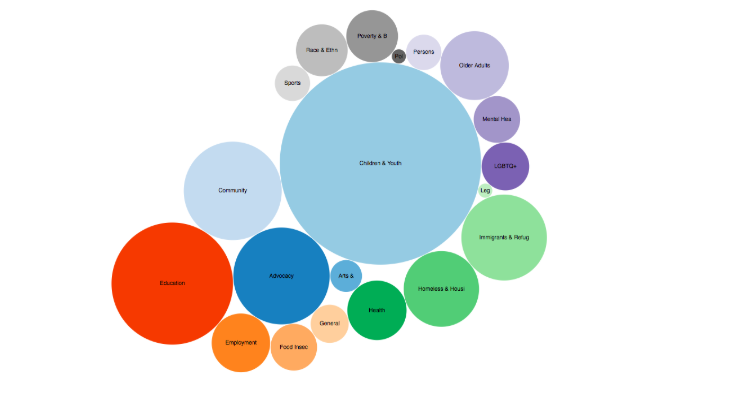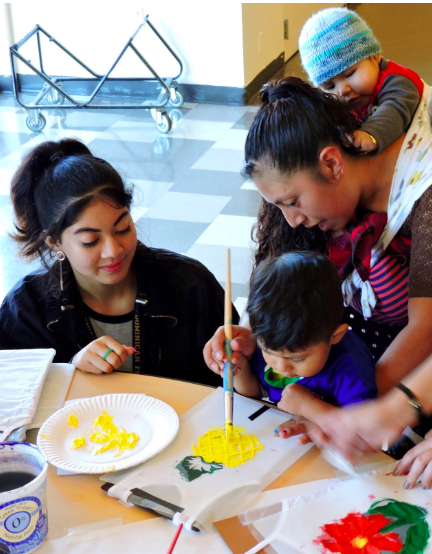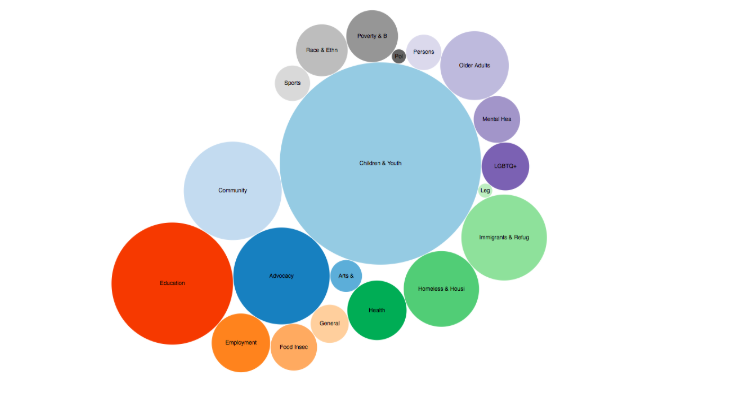This post is part of our Spotlight series, where we spotlight our incredible partners. We are so thrilled that GivePulse has been able to work with these nonprofits, institutions, and corporations!
Sustained Community Relationships
Dominican University of California, located in San Rafael, is a small school (just over 1300 undergraduate students) with a big mission: Dominican “educates and prepares students to be ethical leaders and socially responsible global citizens who incorporate the Dominican values of study, reflection, community, and service into their lives.” The university’s dedication to this mission is affirmed by its receipt of the Community Engagement Classification from the Carnegie Foundation for the Advancement of Teaching “in recognition of the University’s exemplary institutional focus on community engagement.”
Indeed, Dominican University of California is deeply focused on community engagement, as evidenced by the institution’s approach to service-learning. Dominican defines service-learning as “an educational approach that integrates meaningful community engagement with academic curriculum emphasizing critical reflection and analysis.” Dominican has built a service-learning program that create sustained community relationships. These “deep, long lasting partnerships in the community” have emerged from a focus on quality over quantity — a focus that Dominican purposefully maintains.

Dominican University volunteers encourage creativity in their work with students
These “deep, long lasting partnerships in the community” have emerged from a focus on quality over quantity — a focus that Dominican purposefully maintains.
“Even if our students are only there for fifteen, sixteen weeks a semester, we have more students coming the next semester,” says Julia van der Ryn, Executive Director at the Center for Community Engagement. “A lot of times we do retain students, but this way it’s not about getting students to stay at a partner — it’s about us being able to sustain the partnership by constantly sending students to work with the partners every semester.”
Reflection and Retention
While Dominican has created a system in which the community relationships last beyond individual involvement, retention of students is certainly important, and van der Ryn says that use of GivePulse correlates to student retention at a given community partner. Use of GivePulse suggests “something very indicative about the organization — their effectiveness and the culture they’re interested in creating.” The partner sites at which “students have really the most sense of belonging and really are excited to be there, making strong connections” are “the same partners that really value reading the GivePulse reflections of our students.” Indeed, some partners even print out the reflections; reflections are a key tenet of community partners’ learning about how community members are engaging.
Community partners with whom “students have really the most sense of belonging… are the same partners that really value reading the GivePulse reflections of our students.”
Dominican University of California thinks that this interest in student reflections might point to “the particular people who are supervising our students, and their approach, and the culture they want to create at their site.” The sites with cultures that support sustained student involvement are the same ones “who tell us how interesting it is to get the insights of the students.” The benefits are mutual; these same partners say that they “take ideas back from the students” to their organization and leadership.
Dominican plans to “form a group of our community partners” to talk more about the culture they can create: “We know it creates more sustainability in terms of our students wanting to return to those partners, which translates to more success in helping the people they’re serving in their community.” GivePulse, according to van der Ryn, has “helped strengthen these sustained relationships — they’re more relationships than just partnerships.”
Sustained Relationships: Becoming Part of the Community
The degree to which community partners were using GivePulse came as something of a surprise to Dominican. Dominican “had no idea the extent to which they were accessing or reading” reflections.
This extensive use of GivePulse shows how much it has helped community partners. Community partners see the value of this system. It “inspires them to hear from students,” particularly given that they “welcome feedback to improve their programs.” Additionally, nonprofits are able to use the data gathered from GivePulse for grant applications, and are able to build program capacity through the influx of Dominican University of California students.
This is crucial given the many ways that partners engage with the community. Some partners, like Canal Alliance, have a variety of aspects, including “adult ESL, middle school and after school programming, legal services, a food pantry — all these multiple, wrap around services.”

Community partners often engage with a variety of causes
With GivePulse, the university becomes “part of the community” working toward these varied goals. Before using GivePulse, an Excel spreadsheet that needed regular manual updates was used to maintain an accurate record of student involvement. Now, Dominican can keep track of student engagement “in real time,” and can know exactly where students are engaging.
With GivePulse, Dominican can keep track of student engagement “in real time,” and can know exactly where students are engaging.
Dominican can also keep track of any issues or “things that need to be ironed out,” both by accessing student reflections and by accessing logistical information about which students have registered for courses and site placements. This provides an “overview of where the [service-learning] class is at any time.” In this way, GivePulse provides a snapshot of engagement, for both academics and community relationships.
Beyond Mandatory
Faculty members appreciate this snapshot in their service-learning classes, describing GivePulse as a “go-to” for making sure that their classes are “on track.” Faculty incorporate GivePulse in different ways — some ask only that students record their hours, while others use the platform as a repository for prompts, essays, and other qualitative forms of information.
In all of these cases, student usage is mandatory; faculty include GivePulse usage in evaluating students, incorporating grades for both hours and for impact reflections.
Faculty members describe GivePulse as a “go-to” for making sure their class is “on track.”
Student participation sometimes starts at this mandatory level and grows into individually motivated use of the platform. One student, Michael Gomez, began using GivePulse to record his hours for a service learning course. From this course, he was hired for a service-learning job, and ultimately took over the position that trains students for service-learning at Canal Alliance.

Dominican University students paint with community members
Another student, Karla Hernandez, also works with Canal Alliance. She took a service-learning class and “just became so impassioned” that she declared the Community Action & Social Change Minor and became an SL student leader in the organization. Her belief in the importance of using GivePulse’s capabilities is palpable: when in charge of verifying student hours, Hernandez refused to verify reflections if students did not write enough or were “vague and slapdash,” writing to tell them that they “need[ed] to write more.”
Service Learning Opportunity
These stories do not just point to students become increasingly adept at GivePulse — they also reveal the importance of service-learning as gateways to opportunities in community engagement organizations. Dominican is aware of the importance of community relationships not just to the community, but also to the students involved.
On their website, Dominican cites studies that show that “Service-learning and student-faculty research can boost your learning and other gains like personal and social development by 81%,” and that “69% of employers are more likely to hire someone who’s done a community-based project.” The university offers mentorship through integrative coaches and academic advisors to direct students toward community engagement opportunities aligned with their personal and professional goals.
GivePulse helps the university leverage students into positions that provide increased access to work in areas in which they are interested. By seeing which students “really seem engaged” on GivePulse, the university can “tap” these students for future roles in student leadership, and can encourage them to consider majors and minors that call upon their work in the community. In this way, GivePulse offers growth opportunities for students invested in community engagement.
GivePulse offers growth opportunities for students invested in community engagement.
Students can also use hours and reflections recorded on GivePulse to propel them into new roles and opportunities. The records maintained on GivePulse help students to access “their history and use for future references, jobs, etc.”
Facilitating Community Relationships
The data GivePulse maintains must be organized in such a way that users can easily find and use their records. Dominican feels that having a detailed implementation plan is the most critical factor for universities intending to use GivePulse. Even though they describe themselves as a small university, there are many questions to answer; according to Jenny Bray, Service-Learning Program Coordinator, key questions include: “Who owns what information and who wants to share hours? Who wants to play?” Understanding the interests of different parties using the platform can help to set GivePulse up in a way that offers the most benefit to all.
This involves, crucially, “thinking ahead of time”: figuring out where information should fall in regards to partnerships and departments, which individual contacts to set as admins for nonprofits and how best to make sure that the information all comes back to the university at the source. There are “tons of layers,” Bray says, which “makes GivePulse great.” Her advice “is really think out first how you want to use it and then kind of go from there.”
“I can’t imagine going back to life before GivePulse.”
Elements that they suggest planning before beginning the implementation include deciding which departments will use GivePulse, determining how to make sure partners can be shared between different subgroups, and establishing single sign on to streamline the login process.
They also stress the importance of having someone on the staff who knows GivePulse well and can train others. Creating trainings and Powerpoints that help users understand exactly what workflows to use makes the process “easier and easier.”
“In terms of the logistics and being able to have that bird’s eye view of what’s going on at the beginning of the semester — that is priceless.”
With these steps in place, gathering information becomes as easy as the push of a button. As van der Ryn points out, “The student reflections, all of that — that’s all great, that’s all the icing, but in terms of the logistics and being able to have that bird’s eye view of what’s going on at the beginning of the semester — that is priceless.” Bray agrees, adding that GivePulse offers vast benefits in terms of “the history” and being able to see who was where and for how long. “For the students, faculty, and administrators,” she says, “it is amazing to be able to so quickly access that data.”
Perhaps it is for all of these reasons van der Ryn says of the platform, “I cannot imagine going back to life before GivePulse.”
To discuss how GivePulse can help your institution make an impact in your community, schedule a call with our higher education team.

